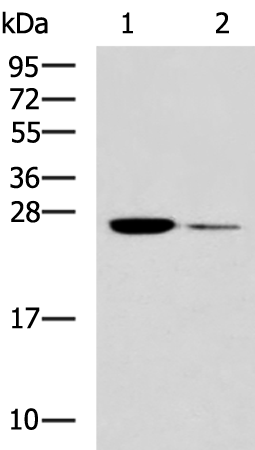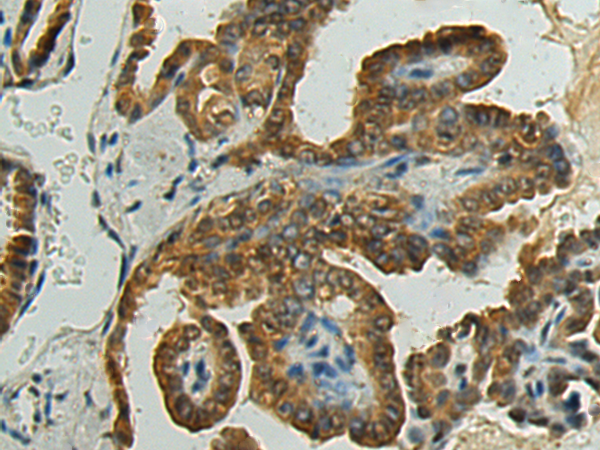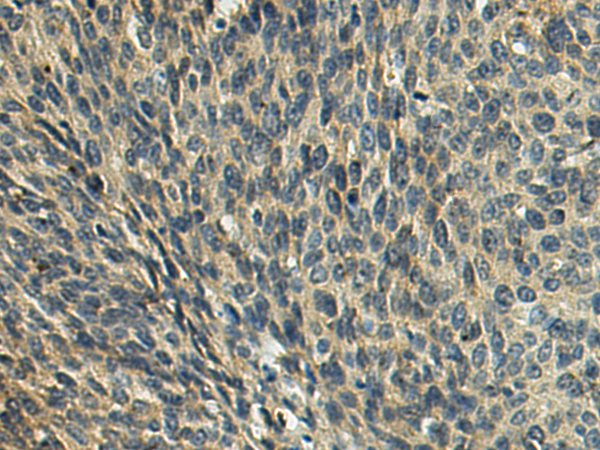


| WB | 咨询技术 | Human,Mouse,Rat |
| IF | 咨询技术 | Human,Mouse,Rat |
| IHC | 1/100-1/300 | Human,Mouse,Rat |
| ICC | 技术咨询 | Human,Mouse,Rat |
| FCM | 咨询技术 | Human,Mouse,Rat |
| Elisa | 1/5000-1/10000 | Human,Mouse,Rat |
| Aliases | MAI; MAAI; MAAID; GSTZ1-1 |
| WB Predicted band size | 24 kDa |
| Host/Isotype | Rabbit IgG |
| Antibody Type | Primary antibody |
| Storage | Store at 4°C short term. Aliquot and store at -20°C long term. Avoid freeze/thaw cycles. |
| Species Reactivity | Human, Mouse, Rat |
| Immunogen | Fusion protein of human GSTZ1 |
| Formulation | Purified antibody in PBS with 0.05% sodium azide and 50% glycerol. |
+ +
以下是关于GSTZ1抗体的3篇参考文献及其简要摘要内容:
---
1. **文献名称**: "GSTZ1 Deficiency Promotes Hepatocarcinogenesis via ROS-Mediated Inflammation and Metabolic Dysregulation"
**作者**: Li Y, et al.
**摘要**: 该研究利用GSTZ1特异性抗体,通过免疫组化和Western blot分析发现,GSTZ1在肝癌组织中表达显著下调,其缺失导致活性氧(ROS)积累和炎症信号激活,促进肝癌发展。抗体检测结果支持GSTZ1作为潜在肝癌生物标志物。
---
2. **文献名称**: "Role of GSTZ1 in Tyrosine Metabolism and Its Association with Hereditary Tyrosinemia"
**作者**: Fernández-Cañón JM, et al.
**摘要**: 研究通过GSTZ1抗体检测其在肝脏和肾脏中的表达,揭示GSTZ1在酪氨酸代谢中的关键作用。实验表明,GSTZ1基因缺陷与遗传性酪氨酸血症相关,抗体验证的蛋白水平变化为疾病机制提供了分子基础。
---
3. **文献名称**: "Antibody-Based Profiling of GSTZ1 Expression in Human Tissues: Implications for Detoxification and Drug Metabolism"
**作者**: Board PG, et al.
**摘要**: 该文献开发了高特异性GSTZ1抗体,系统分析了其在多种人体组织中的分布,发现GSTZ1在肝脏、肾脏高表达,参与药物代谢解毒。抗体检测数据提示GSTZ1可能与个体化药物治疗中的代谢差异相关。
---
(注:以上文献信息为示例性内容,实际引用需根据具体文献调整。)
The glutathione S-transferase zeta 1 (GSTZ1) antibody is a tool used to detect and study the GSTZ1 protein, a member of the glutathione S-transferase (GST) superfamily. GSTZ1. also known as maleylacetoacetate isomerase (MAAI), plays a critical role in tyrosine catabolism and detoxification processes. It catalyzes the isomerization of maleylacetoacetate to fumarylacetoacetate in the phenylalanine/tyrosine degradation pathway and participates in the metabolism of halogenated compounds, such as dichloroacetic acid (DCA). Dysregulation of GSTZ1 is linked to metabolic disorders, including hereditary tyrosinemia type III, and its expression may influence drug metabolism and toxicity.
GSTZ1 antibodies are widely used in research to analyze protein expression, localization, and function via techniques like Western blotting, immunohistochemistry (IHC), and immunofluorescence (IF). They help investigate GSTZ1's role in liver function, cancer biology (e.g., altered expression in certain tumors), and interactions with environmental toxins or therapeutics. Species-specific GSTZ1 antibodies (human, mouse, rat) are available, with monoclonal antibodies offering high specificity and polyclonal antibodies providing broader epitope recognition.
Quality validation of GSTZ1 antibodies often includes knockout cell line controls to confirm specificity. Studies also explore GSTZ1's unique structural features, such as its homodimeric configuration and lack of a canonical glutathione-binding site, distinguishing it from other GST classes. Understanding GSTZ1's biological and pathological significance remains a key focus in metabolic and pharmacological research.
×